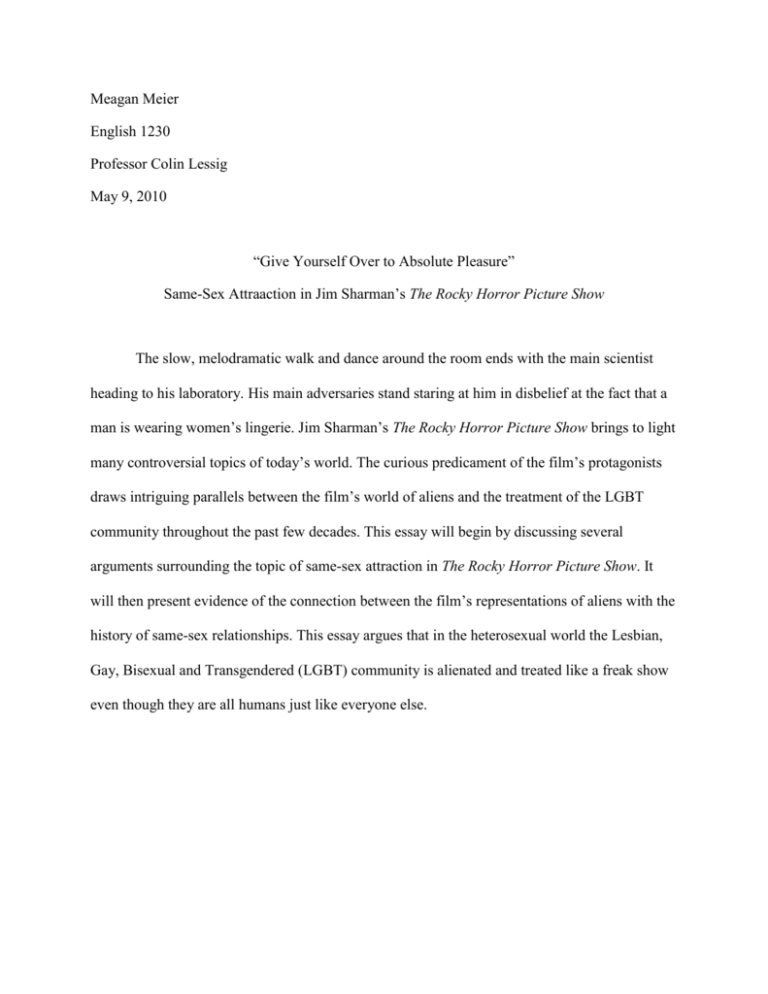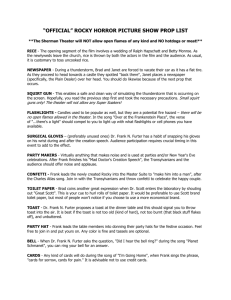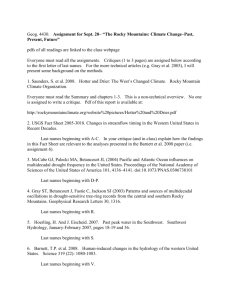Same-Sex Attraaction in Jim Sharman's The - Course
advertisement

Meagan Meier English 1230 Professor Colin Lessig May 9, 2010 “Give Yourself Over to Absolute Pleasure” Same-Sex Attraaction in Jim Sharman’s The Rocky Horror Picture Show The slow, melodramatic walk and dance around the room ends with the main scientist heading to his laboratory. His main adversaries stand staring at him in disbelief at the fact that a man is wearing women’s lingerie. Jim Sharman’s The Rocky Horror Picture Show brings to light many controversial topics of today’s world. The curious predicament of the film’s protagonists draws intriguing parallels between the film’s world of aliens and the treatment of the LGBT community throughout the past few decades. This essay will begin by discussing several arguments surrounding the topic of same-sex attraction in The Rocky Horror Picture Show. It will then present evidence of the connection between the film’s representations of aliens with the history of same-sex relationships. This essay argues that in the heterosexual world the Lesbian, Gay, Bisexual and Transgendered (LGBT) community is alienated and treated like a freak show even though they are all humans just like everyone else. The Rocky Horror Picture Show opens up with a wedding, the happiest day of someone’s life and ends with a death, which is usually the worst day of someone’s life. Brad Majors (Barry Bostwick) and Janet Weiss (Susan Sarandon) are attending the wedding of their friend Betty Monroe. After Betty and her new husband drive off Brad asks Janet to marry him in the song “Dammit Janet”. Later that night they get stranded in the middle of nowhere after the car gets a flat tire. Plus it’s raining. Brad wants Janet to stay in the car while he gets some help, but she refuses to be by herself. They head toward a castle they saw down the road. In the song “Over at the Frankenstein Place” Brad and Janet discover there are lights on in the castle. Brad and Janet ring the doorbell and are greeted by Riff Raff (Richard O’Brien), the handyman. Brad and Janet first meet the main scientist, Dr. Frank N. Furter (Tim Curry) when he sings the song “Sweet Transvestite”. When she first meets him Janet screams in shock and passes out. Brad seems shocked, but not as much as Janet; he just goes with the flow. The next scene takes place in Frank N. Furter’s laboratory. He claims to have found the “secret to life itself”. His creation, Rocky (Peter Hinwood) is brought to life during the song “The Sword of Damocles”. The celebration, however, is cut short when Eddie (Meat Loaf), an ex-delivery boy and partial rain donor to Rocky rides out of the deep freeze on a motorcycle. Eddie is also Columbia’s (Nell Campbell, “Little Nell”) lover. As he comes out of the deep freeze the song “Hot Patootie-Bless My Soul” is being sung. Frank N. Furter, in a jealous rage, kills Eddie with an ice axe then leaves with Rocky. Brad and Janet are given separate rooms and the both of them are visited and seduced by Frank N. Furter. After the ‘incident’ Janet, upset and emotional, leaves her room and looks for Brad. She discovers that, via a monitor in the laboratory, he is with Frank N. Furter. Janet finds Rocky hiding from Riff Raff, who had been tormenting him and while tending to his wounds she seduces him during the song “Touch-a, Touch-a, Touch Me” is being sung. Magenta (Patricia Quinn), Riff Raff’s sister and lover, and Columbia are watching them from their room. Frank N. Furter, Brad and Riff Raff soon return to the laboratory after they discover that Rocky has gone missing. Frank N. Furter learns that an intruder, Dr. Everett Scott (Jonathan Adams) has entered the castle. Dr. Scott is only looking for his nephew Eddie, but Frank N. Furter is extremely worried that his is investigation UFOs for the government. When Frank N. Furter learns of Brad and Janet’s connection to Dr. Scott he suspects that they are also working for him when in reality they aren’t. Rocky and the guests are then served dinner. When they realize that it has been prepared from Eddie’s dead and mutilated body they are quite frankly freaked out; Janet runs screaming into Rocky’s arms. She is chased through the halls by a jealous Frank N. Furter during the song “Wise Up, Janet Weiss”. Everyone meets up in Frank N. Furter’s lab where he captures them with his Medusa Transducer, which transforms them into statues. He forces them to perform a live cabaret floor show even though there is no audience. During the song “I’m going Home” the performance is interrupted by Riff Raff and Magenta who announce that they are planning on returning o the planet Transsexual in the galaxy of Transylvania. They kill Columbia, Rocky and Frank N. Furter. Brad, Janet and Dr. Scott are released leaving Riff Raff and Magenta to depart, lifting off in the castle itself. Some claim that measuring gender equality in the past was a ‘false start’. For example, A. Geske Dijkstra argues that because the Gender-related Development Index, or GDI, and the Gender Empowerment Measure, or GEM, didn’t measure gender inequality they weren’t able to accurately measure gender equality. In “Towards a Fresh Start in Measuring Gender Equality: A Contribution to the Debate”, Dijkstra, a Social Sciences faculty member from Erasmus University Rotterdam, states, “there is a huge need for an index that measures the position and status of women relative to men, independently of the absolute levels of income per capita or human development” (276). Gender equality does not mean equality between the sexes. According to Ferber and Nelson (1993, pp.9-10), “Gender is the social meaning that is given to biological differences between the sexes; it refers to social constructs rather than biological givens”. The fact that women live, on average, longer than men, shouldn’t be deemed unequal or even unfair, it should be regarded as “gender “unequal”. There are eight dimensions to gender equality developed in an international workshop in The Hague and they are as follows: gender identity, autonomy of the body, autonomy within the household, political power, access to social resources (education and health), access to material resources (land and credit), and time use (leisure and sleep)(Dijkstra, 2002). “The search for an index that measures gender equality in all its dimensions does not require to separate the well-being or human development from the agency or empowerment dimensions since the UNDP has done so far” (277). This is all true for Frank N. Furter in The Rocky Horror Picture Show. He is a man who identifies more with women. He is a male cross-dresser who finds pleasure in wearing women’s clothing. Just because he is strays from the “norm” it doesn’t make him any less vulnerable to things that hurt and discourage everyone else. In order to equally measure “gender equality” we must first realize that gender isn’t always primarily based on one’s physical appearance. It is also based on how each individual views themselves and their sexuality. Others claim that the LGBT community shouldn’t have equal rights, in regard to family, as their heterosexual counterparts. For example, Nancy D. Polikoff argues that family is family whether traditional or not. In “Equality and Justice for Lesbian and Gay Families and Relationships”, she states, “Marriage was a problem because it channeled everyone into only one approved relationship, it regulated the lives of men and women along gender lines, and it policed the boundary between acceptable and unacceptable sexual expression” (530). Eventually unmarried persons were allowed the use of birth control, children born outside of married could no longer have a second-class legal status and women had the right to terminate a pregnancy. Yes, none of these were gay rights cases, but “they made marriage matter less”. This would allow an opening in the social and political spheres for the families that didn’t fit the traditional form. The National Pro-Family Coalition, however, argued that the nation was found on “a strong ‘traditional’ family”. They not only argued against gay and lesbian relationships, but also against unmarried couples and children born out of wedlock. Polikoff continues to mention the movements created over the next several decades. She advocates the law reform that values every family and relationship, whether traditional or not, she states “That doesn’t mean that the law should treat all relationships in the same way. It means that we should identify the purpose of any law and include within that the law the relationships that will further its purpose” (558). In the end she believes that marriage should not be the dividing line between who is in and who is out. In “Queering Social Studies: The Role of Social Studies in Normalizing Citizens and Sexuality in the Common Good” Sandra J. Schmidt, from the University of South Carolina, talks about how LGBT issues have gained prominence in political and social arenas (314). It has always been hard for the LGBT community, but within the past few years they have been seeking to gain recognition in the political arena. Forty-five states bar same-sex marriage and more than 20 states do not allow second parent adoption which prevents same-sex couples from adopting jointly. Politicians hardly stand a chance when they are in favor of equal rights for the LGBT community and the education in schools surrounding LGBT issues is rare. “People argue that schools do not teach heterosexuality and, thus, neither should they teach homosexuality” (316). Mark Siegel argues that The Rocky Horror Picture Show is a “rite of intensification” which means it functions to restore social equality where the patterns, or laws, of social interaction are changing, for better or worse. In “The Rocky Horror Picture Show: More Than A Lip Service”, he states “It’s not uplifting, pleasant, heart-warming, star-studded or expensively made but is a raunchy, vulgar and jolting film about beings from another planet coming down to Earth” (305). The film does lack a lot of suspense, but the plot is basically a parody of science fiction plotting and the Hollywood musical genre. The Rocky Horror Picture Show is a cult classic and still loved because it isn’t like a lot of other films out there. While the interpretations of these authors and scholars offer excellent illustrations of themes in The Rocky Horror Picture Show they fail to focus their emphasis on one theme expressed in the film: Equal Rights, and its parallels with the way the United States treats the LGBT community. The authors analyzing these aspects of The Rocky Horror Picture Show assist their readers in understanding the heterosexual point of view, or mindset, in relation the film’s ever-changing surroundings. While these views add value to the film’s message, they focus mainly on the thought and feelings of the heterosexuals of the film. But, these themes leave out the point of view of the members of the LGBT community. Showing a larger view of how FrankN-Furter (and other members of the LGBT community) is affected by Janet’s standpoint on his “existence” would better communicate the overall themes of the film. This essay will express another theme found in The Rocky Horror Picture show: Gender Equality, and what gender truly is. This view, like the others I’ve discussed, revolves around the reactions of heterosexuals to the LGBT community. Not everyone in the LGBT community is treated equally; they don’t have all the same rights as others around them and they are seen as somewhat freakish. This is shown in The Rocky Horror Picture Show when Brad and Janet meet Dr. Frank N. Furter for the first time. Janet’s first reaction to seeing Frank N. Furter, a muscular man dressed in women’s clothing, is to scream and faint while her fiancé seems to just go with the flow of things. Janet passes out two more times while Frank N. Furter sings “Sweet Transvestite”. This goes to show that members of the LGBT community are sometimes treated unequally when someone learns that a friend or family member is part of that community. People even seem to treat members of the LGBT community unfairly without even getting to know them beforehand. In order for everyone to be accepted in society, the youth of the United States (as well as the world) needs to be educated on certain LGBT issues. “The field of education does little to directly address the manner in which LGBT issues should be incorporated into schools. These decisions are left to individual communities. The most widespread remedies used are anti-bullying policies and education designed to curb the physical and emotional violence which affects LGBT youth” (Schmidt 315). This is a good start and in most cases emotional abuse it much worse than physical violence; physical wounds can take less time to heal than emotional scars. Roger Myrick and Betty Robbins wrote an article in the Journal of Gender Studies titled “The Function of the Fetish in The Rocky Horror Picture Show and Priscilla, Queen of the Desert” and state that “male drag offers an interesting synthesis of transvestitism and the masquerade” (271). Just because they are attracted to someone of the same sex or cross-dress does not make them a bad person; it makes them an individual and unique to those around them. Love is love and it sees no gender; love defies limits. This is evident in The Rocky Horror Picture Show. Dr. Frank N. Furter is attracted to Rocky, his creation, Brad Majors and Brad’s fiancée Janet Weiss. In order to seduce Janet Frank N. Furter disguises himself as Brad and in order to seduce Brad he disguises himself as Janet. Frank N. Furter goes into a jealous rage after he finds out that Janet seduced Rocky which shows the viewer that he cares about him. It isn’t important who we love, but that we truly love that person. Love is by definition sacred; not some love between some people, but all love between all people. They should be allowed to love whoever they want without someone passing judgment on them. In the end love conquers all. A person is going to love whoever they want and they are going to fight for that right. You don’t always get to choose who you will fall in love with. It just happens, but it is love nonetheless. Valerie Berlin wrote a case study titled “Gays and Lesbians Fight Back-and Win” in which she talks about the fight for same-sex marriage. “We’re not scary or threatening. We are just like you.” Every single member of the LGBT community deserves the same respect as all the heterosexuals in the world. In the beginning of The Rocky Horror Picture Show two people (a man and a woman) have just gotten married. Even though same-sex marriage is viewed upon as wrong and ‘disgusting’ the LGBT community will continue to fight for the right to marry the person they love. In conclusion, this essay argued that the Lesbian, Gay, Bisexual and Transgendered (LGBT) community is alienated and treated like a freak show even though they are just like everyone else. Many of the characteristics of the treatment of the LGBT community, namely by people who don’t understand or are uncomfortable with sexually, are also present in Dr. Frank N. Furter’s world. Love is love and it sees no gender. Dr. Frank N. Furter himself shows this with the fact that he loves and cares for his creation Rocky who also happens to be a man. When the aliens in The Rocky Horror Picture Show are viewed as a member of the LGBT community, the film’s story can be seen in another light. The Rocky Horror Picture Show paints a pessimistic picture; one where members of the LGBT community will be forever outcast and alienated by those who do not understand them. In the end love conquers all. A person is going to love whoever they want and this is and always will be the ‘norm’. Gender doesn’t matter as much as the love one person has for another. The world will be a better place when everyone is treated equally. Works Cited Beals, Jennifer. Speech. POWER UP's Annual Gala. Hollywood, California. 20 Oct. 2007. Web. Apr. 2011. <http://www.youtube.com/watch?v=HREE0i0red8>. Berlin, Valerie. " Gays and Lesbians Fight Back-and Win." 24 May 2010. Campaigns & Elections. 5 May 2011 <http://www.campaignsandelections.com/publications/campaignelection/2010/may-2010/consultant-case-study-gays-and-lesbians-fight-back-and-win>. Browning, Skylar and Jessica Mayrer. 15 April 2010. Missoula Independent. 5 May 2011 <http://missoulanews.bigskypress.com/missoula/diversity-and-respect/Content?oid=1245682>. Dijkstra, A. Geske. "Towards a Fresh Start in Measuring Gender." Journal of Human Development (July 2006). Internet Movie Database. 1990. 2011 <http://www.imdb.com/title/tt0073629/>. Myrick, Roger and Betty Robbins. "The Function of the Fetish in The Rocky Horror Picture Show and Priscilla, Queen of the Desert." Journal of Gender Studies (Nov2000): 269-278. Polikoff, Nancy D. "Equality and Justice for Lesbian and Gay Families and Relationships." Rutgers Law Review (Spring 2009): 529-565. Redman, Daniel. "Where all Belong: Religion and the Fight for LGBT Equality in Alabama." Berkeley Journal of Gender, Law & Justice (2006): 195-212. "Rocky Horror Picture Show." From Abba to Zoom: A Pop Culture Encyclopedia of the Late 20th Century. 2005. 405-405. Schmidt, Sandra J. "Queering Social Studies: The Role of Social Studies in Normalizing Citizens and Sexuality in the Common Good." Theory and Research in Social Education (2010): 314-335. Siegel, Mark. "The Rocky Horror Picture Show: More Than A Lip Service." Science Fiction Studies (Nov80, Vol. 7 Issue 3): 305-312. The Rocky Horror Picture Show. Dir. Jim Sharman. Perf. Susan Sarandon, Barry Bostwick Tim Curry. 1975. "Time Warp." From Abba to Zoom: A Pop Culture Encycloopedia of the Late 20th Century. 205. 488-489.




